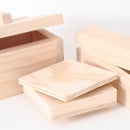Introduction: Etched Minty Valentines Candy Box
Or.. a good demonstration of why throwing a radio into the bathtub will kill you. I'll explain later.
Speaking of killing you, as we are using water and electricity here, please be supper-duper cautious. I can't be held responsible for burned fingers, house fires, dead cats or any combination thereof. Please use some common sense!
This is a decent project that should cost you little or no money, depending on what you have laying around the house. The idea is to use electricity and salt water to etch an image into the top of an altoids tin. The same process can be used to actually cut the image all the way through if allowed to go long enough. I'll explain the principles behind this as we go along.
First things first, Project materials and cost:
1 Altoids can, or similar metal canister - $0 (I'm using garbage here...)
1 spare DC power supply brick. 5v or greater. Preferably a decent amperage. I use a 12v 1A supply. it really seems to make no difference beyond how long the etch will take - $0
Old PC case fan, light bulb.. something that will run on the current from the power supply. This is used to limit the amount of current being transmitted, as you don't want to burn out the power supply. - 0$
1 PLASTIC bowl or pan. Never NEVER use a metal pan of any kind. - 0$
About half a cup of salt. - 0$
A couple of bolts and some heavy copper wire - optional 0$
Plastic packing tape (I use clear.. don't have to I suppose.). Not masking tape. It has to stand up to salt water - 0$ I steal mine from my day job.
Sandpaper, or green scrubby. -0$ I used the scrubby from my kitchen sink. Don't tell the girlfriend.
Razor blade or knife. I highly recommend an Exact-o or similar, although I did this with a straight "utility" style blade.
Step 1: Prep the Minty Tin
For the tin to etch properly, the top of the tin will need to be cleaned to bare metal. This can be done with a fine grade of sandpaper, or a green scrubby. I tend to go with a little of both.
Run the tin under hot water and sand lightly until most of the paint is gone. then clean it up with the scrubby. any areas where there is paint remaining will not etch properly, so take your time.
When it looks clean, rinse and dry it off thoroughly. At this point, try not to touch the surface any more than you have to . The oils from your skin could affect or block the etching.
Step 2: Masking the Tin and Draw Your Design
You need to mask off the top of the tin. Cover the bare metal with the packing tape. If you use more than one strip of tape, leave a little overlap to assure that you have a water tight seal between the pieces. Any bare metal still revealed at this point could wind up being etched. Try and work out all the air bubbles and make sure the edges are covered.
Taking a sharpie or other pen that will draw on the tape, sketch out your design. it's OK to be a little sloppy. I had drawn in some writing here, but abandoned it in the next step. I'll add my "message" later. You will be cutting around the design.
Step 3: Cut Out the Design
This one can take some practice, depending on how steady your hands are. Using the razor, carefully cut out the design from the tape. In this case, I went around each side of the lines I had drawn, then using the tip of the blade, peeled the tape out of the line, leaving the bare metal exposed.
Where ever you remove the tape, the metal will be etched. Mistakes are fine. don't panic. If something gets cut by accident, just use another piece of tape to seal it up again. your just creating a mask here to keep the water off certain areas. Your cutting does not have to be a work of art. it just has to get the job done.
This step can take some time. Be patient and work slow. I abandoned the writing in my design as it was just too small and I was using the wrong blade for really delicate work.
I'll take this opportunity to point out an option. You could also draw your design on the bare cover using a sharpie or other non water based ink. The etch would then remove all material not covered by the sharpie. I prefer the mask and cut out method. It gives you much cleaner lines, and just looks nicer when done. I have examples of both methods later in the instructions.
Step 4: Set Up the Etching Station
WARNINGS:
**************************************************************************************************
There are several important points to make here.
First, you must use a DC power supply. An AC supply will have little or no effect, no mater how strong. AC current stands for Alternating current. It means that there really is no "positive" electrode. The current in AC circuits alternates directions. The electrons will never flow consistently enough in one direction to transfer metal particles. The Mythbusters (US Discovery channel show..) actually demonstrated this theory in episode 26 "Salsa escape)
http://dsc.discovery.com/fansites/mythbusters/episode/episode_06.html
Jamie and Adam attempted to cut their way through prison bars using this method and salsa as the liquid. Adam used direct AC current from the wall, Jamie used DC from a smashed radio power supply. Adam's had no effect.. Jamie's bars were cut clean off.
Second, DO NOT plug in the power supply until everything is set up. plugging it in is the last step before etching starts.
Third. When testing the PC fan, don't accidentally put your finger in there and cut it like I did that one time.
Fourth. If you have cats, keep the cords up and tight. It will make a spectacular and dangerous mess when your cat grabs a wire and runs for it.... little sh**s...
Fifth. I should not have to say this, but I will. In no case under any circumstances at all ever should you run house (mains - for those of you overseas) current directly into the solution. it just won't work for one thing, and could very easily kill you.
Last, you are using electricity here. Please be careful.
****************************************************************************************************
The basic idea of using electricity to plate or etch metal has been around for a long time. In fact, it has been the subject of several articles:
https://www.instructables.com/id/EKVI03SL4PEV2Z566X/
There was another one where a guy used the same process to cut a design into his PC case, but I can't find it right now...
It's essentially the same principle used to chrome or gold plate metal. You put the positive electrode on one metal, and the negative electrode on another. When you submerse them in a conductive liquid, like saturated salt water, the electrons will flow from one metal to the other, taking some of the metal with them. You will get the idea.
This is also (in principle) how throwing a radio in the tub will kill you. The electricity will flow from the radio, through YOU, to the metal drain in the tub. Mythbusters episode 19:
http://dsc.discovery.com/fansites/mythbusters/episode/00to49/episode_07.html
Take the plastic bowl and fill it with about 2-3 inches of lukewarm water. Slowly dissolve the salt into the water until it won't take any more. This is a saturated salt solution. You could use regular water without the salt, but it would require more electricity, and take far longer. The salt increases the conductivity of the water greatly.
For the process to work, the two metals should be close, but not touch in the water. I usually pinch the negative wire between the lid and base of the tin, then connect the positive electrode to the fan, and then to two lengths of copper wire wrapped around some bolts. Check the diagram and picture below. The bolts just help create more surface area. You could use the wire alone. I usually use two bolts. It spreads the effect out better. If you only used one electrode, try to get it centered under the piece. If it's off to one side, the etch could be uneven.
In this case, I have the bolts on the bottom of the pan, add the tin floating upside down in the water. It works just as well to flood the tin and have it submerged in the water.
Step 5: POWER ON!
OK. Once you have it all together, make sure the tin is not touching the wire/bolts in the liquid. Make sure nothing is shorted. Make sure your fingers are not in the fan. Put the cat in the closet.
Plug in the power supply. For safety - DO NOT leave the room. Sit there and watch. It should not take that long. And it's cool looking.
You should immediately notice the fan spinning, and bubbles rising from the bolts. If none of this is going on, unplug the power and check all your connections. It could be one of several things.
1. Wires crossed or wired incorrectly. The positive should be on the tin, the negative on the wire/bolts. Make sure nothing is shorting out. If the bubbles are only coming off the tin, you have it wired backwards.
2. Parts are too far apart. Try to make it less than an inch, if you can.
3. Not enough power. You might need a stronger supply.
Once you have bubbles, you will notice the water start to change colors. It can vary depending on the metals you are using. There will eventually be some scum as well. This is all normal. In the pictures, you can see mine going a bit orange.
Let it go for about 5 minutes. You can check every now and then to see how it's working. Times will vary depending on the strength of your power supply. Once it appears to be etched to your satisfaction, unplug the power, and remove the tin. Rinse it well in warm water, and remove the tape. If any adhesive is left behind, just clean it off with GOO GONE or some such solvent.
I would not recommend using the bowl for food after this. The scum left behind should be explanation enough.
Step 6: Ta-DA!
Bingo! Etched Tin. Do a little dance and go show the neighbors.
If you were to allow the etch process to continue, it could cut all the way through the metal, creating a cut-out design.
You could stop here, or you could get fancy. I got fancy.
Using another idea, I opened the tin, and wrote my message on the inside of the lid using a sharpie. Any non-water soluble pen should work, but you will need to get it off again, so don't go crazy.
I covered the top of the lid in tape again to protect it. I then etched the lid portion using the same process. The areas where the sharpie was resisted the etching (pretty well anyhow) leaving the writing behind. After it etched a bit, the cat knocked the whole damn thing over. It had worked pretty well by that point though. I rinsed it, removed the tape from the top and lightly used a green scrubby to remove the sharpie revealing the un-etched area underneath.
I took some spare fabric we had laying around and glued it to the inside. I would have preferred felt, but you work with what you have. I'm filling it with chocolates for my beautiful and fabulous girlfriend. Sorry about the bowl and scrubby dear.
Good luck, be safe and have fun!
Participated in the
The Instructables Book Contest













